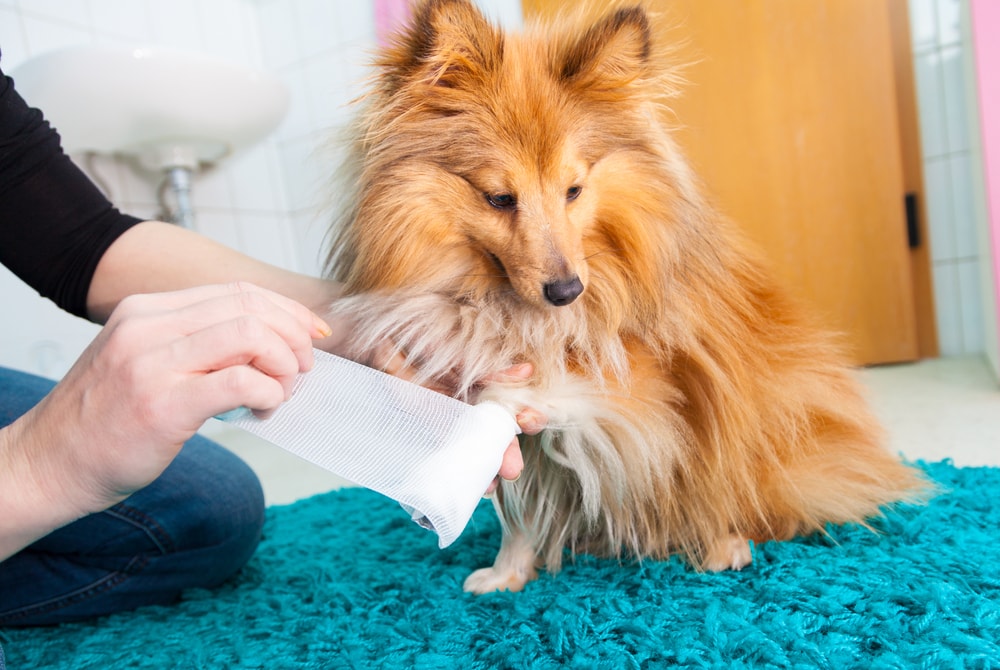Dogo Argentino vs Doberman: Main Differences (With Pictures)

By Misty Layne
Updated on
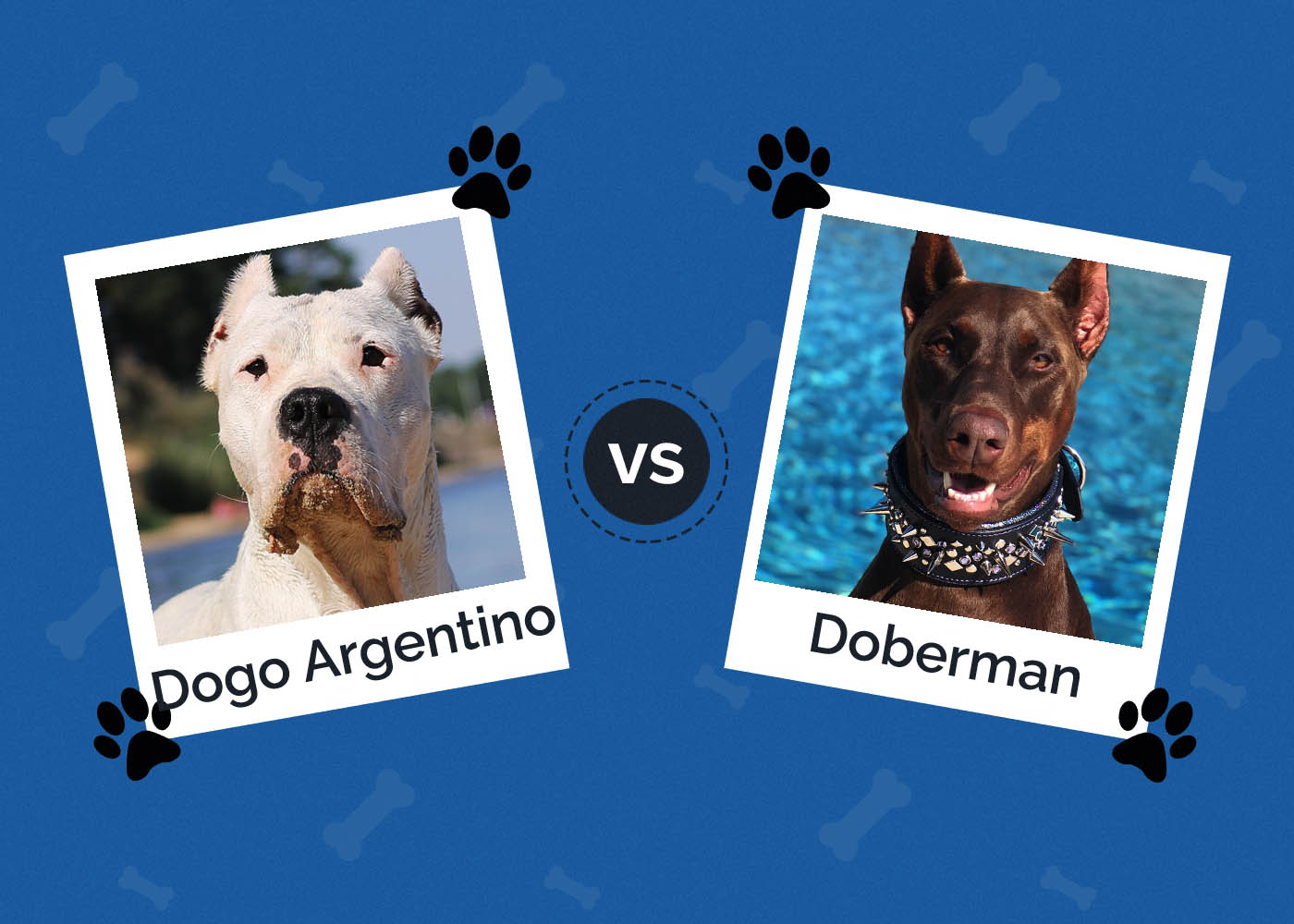
Choosing the right dog breed for a pet can be challenging, especially if you’re considering two breeds that are similar in temperament or looks—such is the case with the Dogo Argentino and Doberman. They may look nothing alike, but both breeds are active, intelligent, loyal to a fault, and capable of making excellent pets (despite their less-than-stellar reputations).
Keep reading to discover the differences between these two breeds, so you can make an informed decision on which might be the best pet for you!
Visual Differences
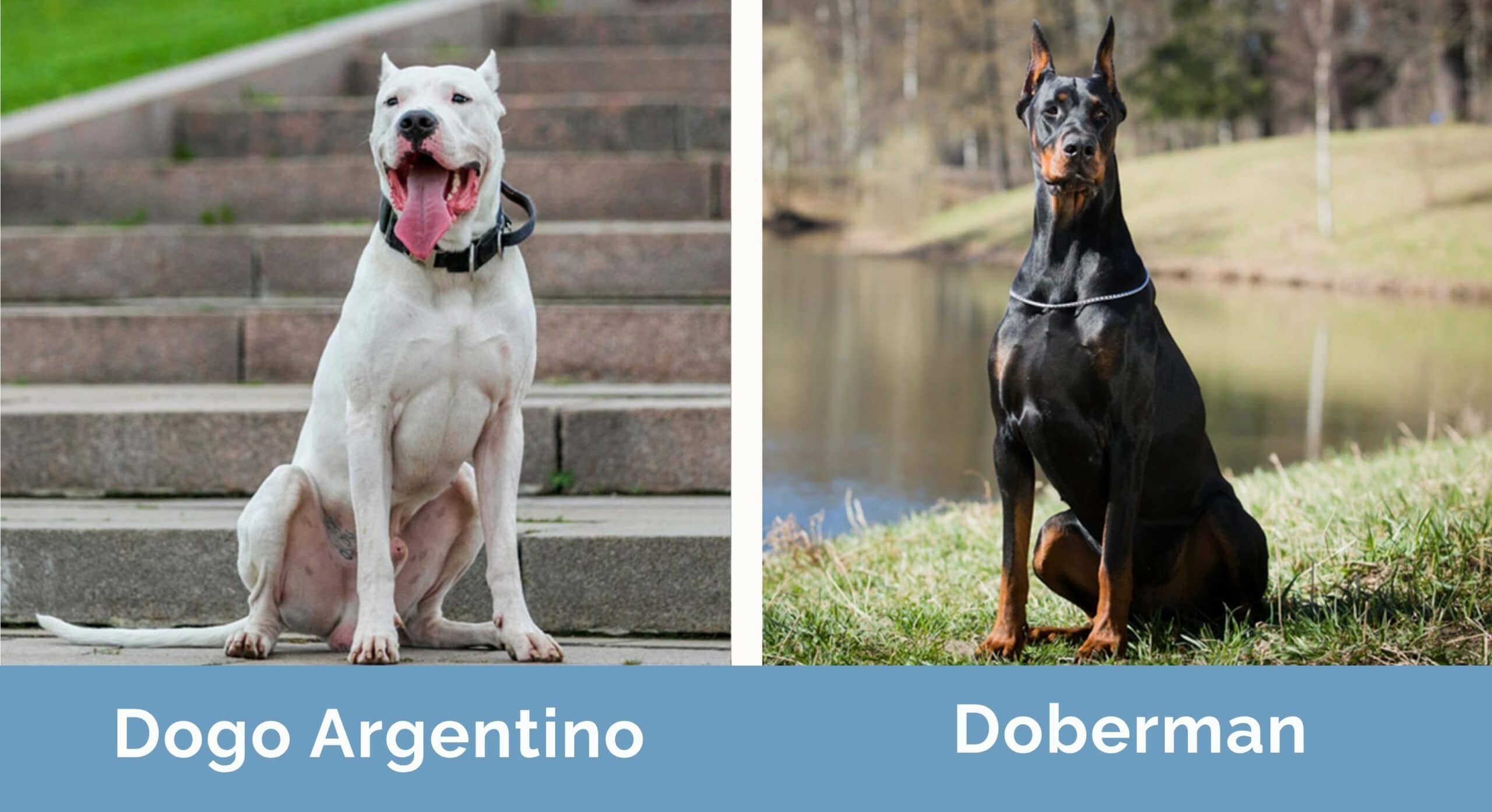
At a Glance
- Average height (adult): 23–27 inches
- Average weight (adult): 80–100 pounds
- Lifespan: 9–15 years
- Exercise: 1–2 hours a day
- Grooming needs: Mild
- Family-friendly: Depends
- Other pet-friendly: Not really
- Trainability: Highly active, smart, loyal
- Average height (adult): 24–28 inches
- Average weight (adult): 60–100 pounds
- Lifespan: 10–12 years
- Exercise: 1+ hours a day
- Grooming needs: Mild
- Family-friendly: Yes
- Other pet-friendly: Sometimes
- Trainability: Protective, active, loving
Dogo Argentino Overview
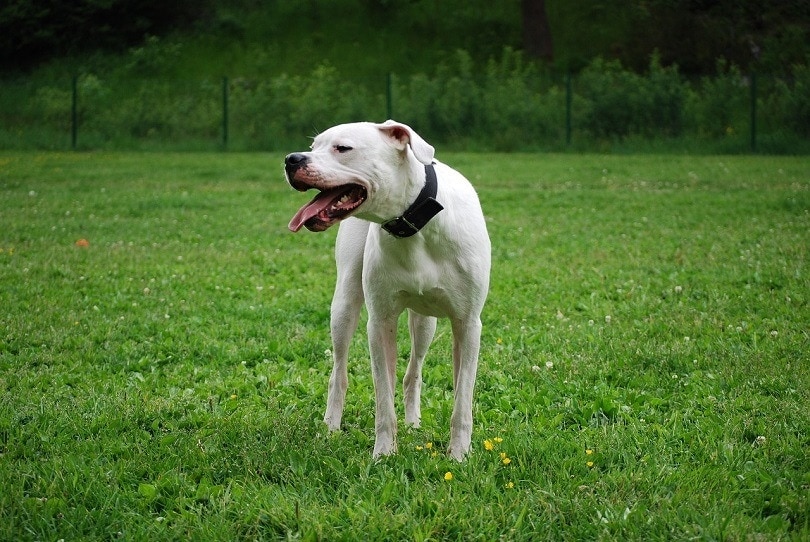
The Dogo Argentino may go back to 1920, but it was only recognized by the American Kennel Club (AKC) 1 in 2020, so it’s a bit of a newer breed. It’s also a sort of designer breed in that it was specifically created 2 to hunt large game.
This dog is strong and can easily protect what it considers its own. But this pup is also a sweet, loving dog, making it an excellent pet as well as a guard dog. If you’re the type to be constantly on the go with activities such as running or hiking, this dog will be your best friend, as it’s highly active.
Temperament
The Dogo Argentino is a pup that is both fierce and gentle. This pup will be extremely loyal and devoted to its family and will jump in at a moment’s notice to protect them. While the Dogo will accept strangers into the home, it will also be wary of them.
Though this dog may not be the cuddliest, it doesn’t mean it doesn’t want to be near its people. The Dogo will be eager to always be close to or to touch family members.
But this dog is also incredibly independent and sometimes stubborn—that means you will need to be confident enough to assert your position as leader of the pack. And because the Dogo is so active, be prepared to fit in plenty of exercise each day.
As a working dog, the Dogo will do best if it’s given some type of job to do around the home.
Training
You’ll need to begin training your Dogo Argentino the minute you bring it home. This dog breed is extremely intelligent, which will aid in training, but its stubbornness may cause some issues here and there.
Early training and socialization are vital with this breed to avoid negative traits that can appear, such as aggressiveness and wariness when it comes to people the dog doesn’t know, as well as becoming too headstrong. Early socialization will also help this dog around other animals; the Dogo Argentino was designed to hunt, so it has a high prey drive that can translate to harming smaller animals, such as cats, if not properly trained and socialized.
If you aren’t sure if you’re up for the job, you can find a reputable trainer to help you with the task.

Health & Care
Unfortunately, the Dogo Argentino does have a few major health concerns you may need to contend with. These include:
- Hypothyroidism
- Glaucoma
- Deafness
- Hip dysplasia
- Laryngeal paralysis
Suitable For:
The best family for a Dogo Argentino is one made up of adults and children that are nearly grown, as this pup doesn’t generally have the patience for small children. The Dogo will also make an excellent pet for those looking for a regular running and hiking partner.
When it comes to those with other pets in the home, though, you will be better off going with another breed. The Dogo isn’t particularly friendly with other animals. Considering its high prey drive, it could harm or accidentally kill a smaller pet.
Doberman Overview
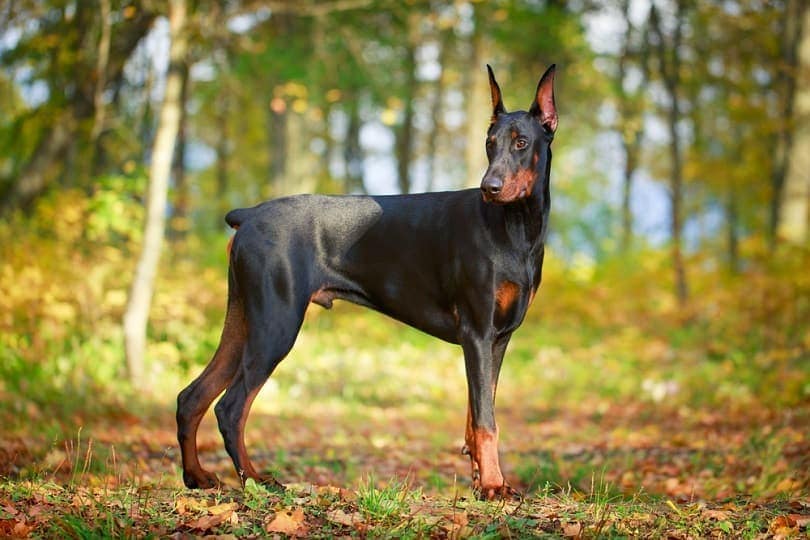
The Doberman breed came about because a German tax collector in the 1890s 3 decided he needed a guard dog to have his back. That makes the Doberman a newer breed of dog. It also makes the Doberman a mixed breed, as the tax collector experimented with several dogs to perfect his guard companion. What breeds make up the Doberman are unknown, though possibilities include the Great Dane, Rottweiler, black and tan terrier, Manchester Terrier, Weimaraner, Greyhound, German Shorthaired Pointer, and Beauceron.
This working dog breed is hard-working, loyal, and protective and makes a fabulous pet for the right person or family.
Temperament
The Doberman has a rep for being aggressive because that’s literally what it was bred to be. However, breeders have been breeding out aggressive traits for a while now, which means this breed is much less aggressive than you think. In fact, they can be downright loving sweethearts! And if they are properly socialized from a young age, these dogs can be protective, loyal, and caring towards you and your family (including small children).
The Doberman breed is also intelligent, which makes training them simpler. But that intelligence can also lead to boredom if these pups aren’t kept active and mentally stimulated. And if boredom comes about, the Doberman can become destructive or engage in other negative behaviors like barking constantly.
Training
As we said, the Doberman is clever, which is great because it helps when it comes to training. And training is a must with this breed to avoid unwanted aggressiveness or other such behaviors. Early socialization is also vital, as the Doberman will need this to learn how to get along with strangers and other animals.
Dobermans require positive reinforcement during training, so be prepared with plenty of treats and praise. They also do exceptionally well with clicker training, so you might want to look into that. And again, if you feel you don’t have the time to devote to training, a reputable trainer can lend a helping hand.
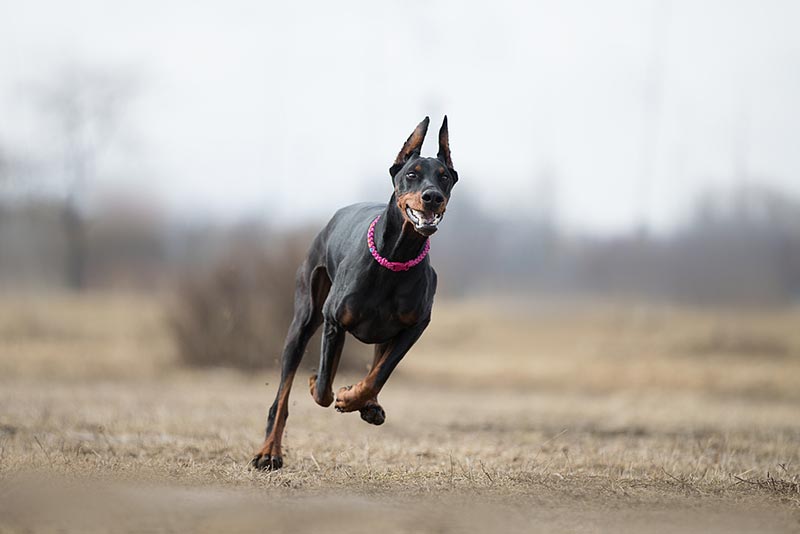
Health & Care
Though a fairly healthy breed, there are some diseases the Doberman is more prone to getting. Some of these are:
- Hepatitis
- Von Willebrand’s Disease
- Eye problems
- Cardiomyopathy
- Bloat
Suitable For:
While the Dogo Argentino isn’t a good fit for families with small children, that isn’t the case with the Doberman. As long as this breed is trained and socialized from the moment they get to your home, the Doberman can make an excellent pet (and protective watchdog) for young children.
However, the Doberman breed can occasionally develop a possessive bond with a single member of the home, which can lead to separation anxiety and aggression when its chosen person is away. And if properly socialized from a young age, the Doberman can get along with most other pets, including cats.
Which Breed Is Right for You?
Whether the Dogo Argentino or Doberman is right for you will depend on who lives in your home and how active you are. The Dogo Argentino won’t be a good fit for homes with young children or other pets, but the Doberman will do just as well in those homes as in single-person homes. Both dogs are incredibly active and need plenty of exercise each day. Both breeds are also intelligent, which can lead to boredom and destruction if not kept busy and mentally stimulated.
Consider which could be the better fit for your family (or if you should go with a different breed altogether) before adopting any dog.
See also:
Featured Image Credit: (L) Eve Photography, Shutterstock | (R) Jen B, Unsplash






